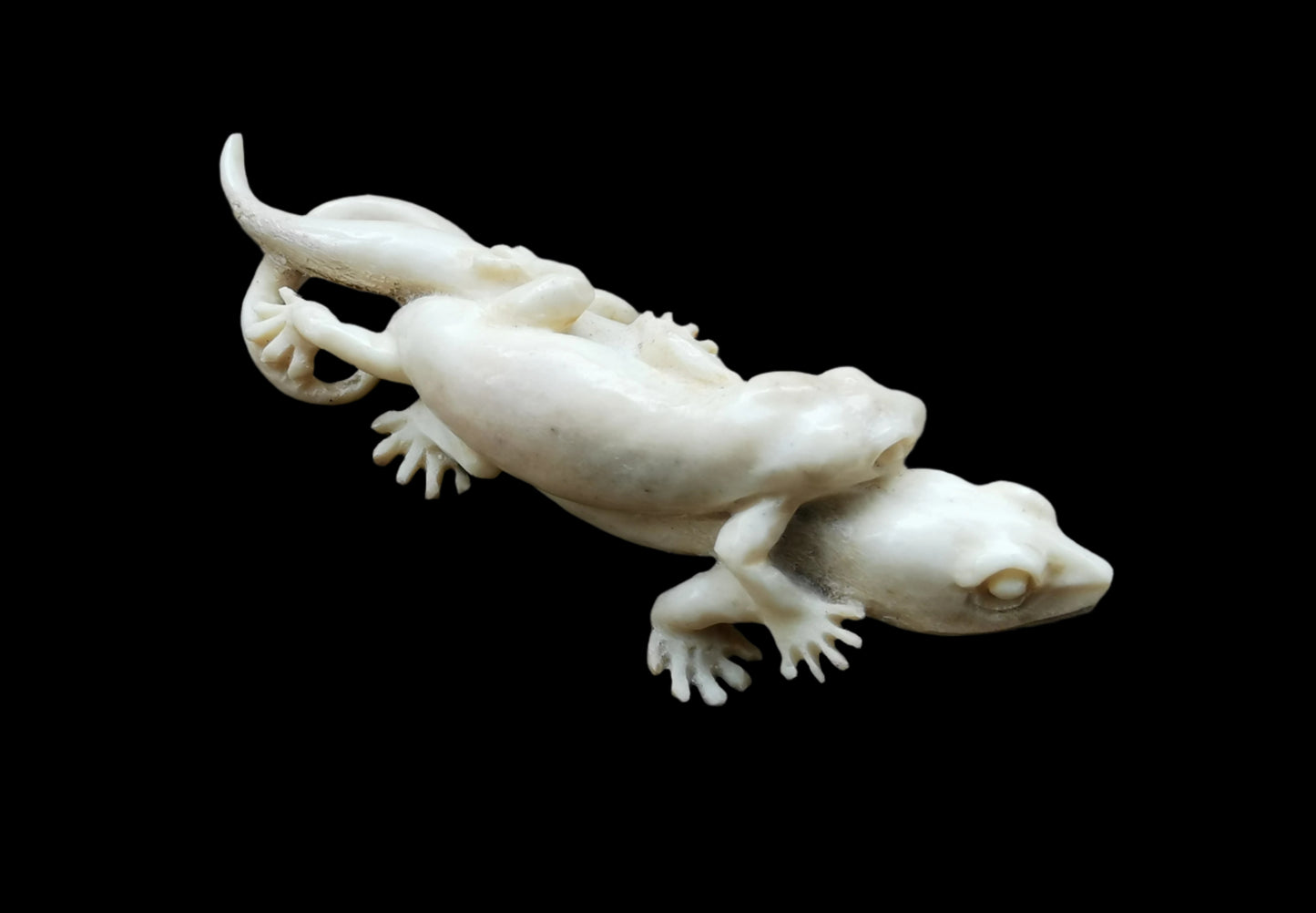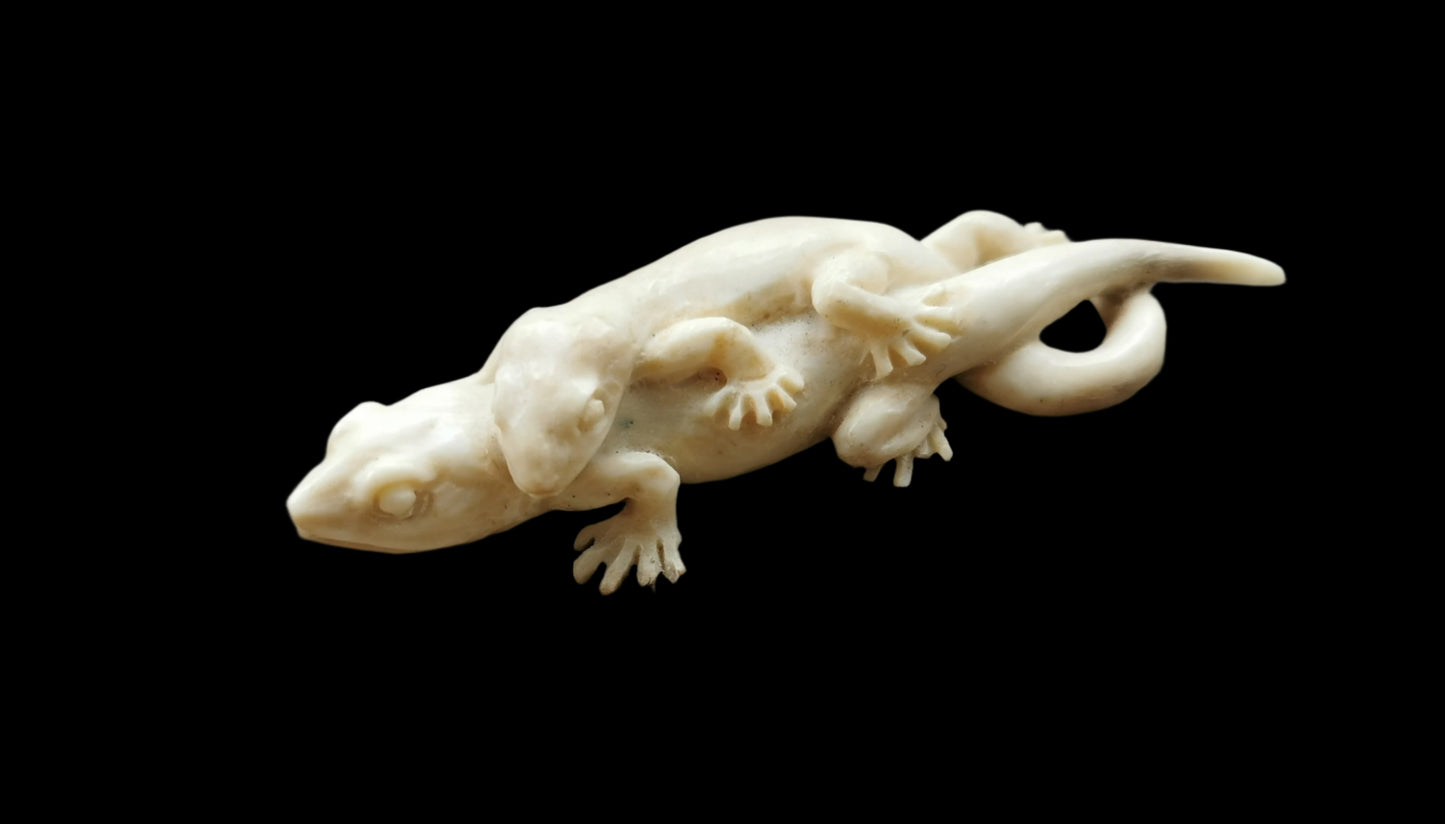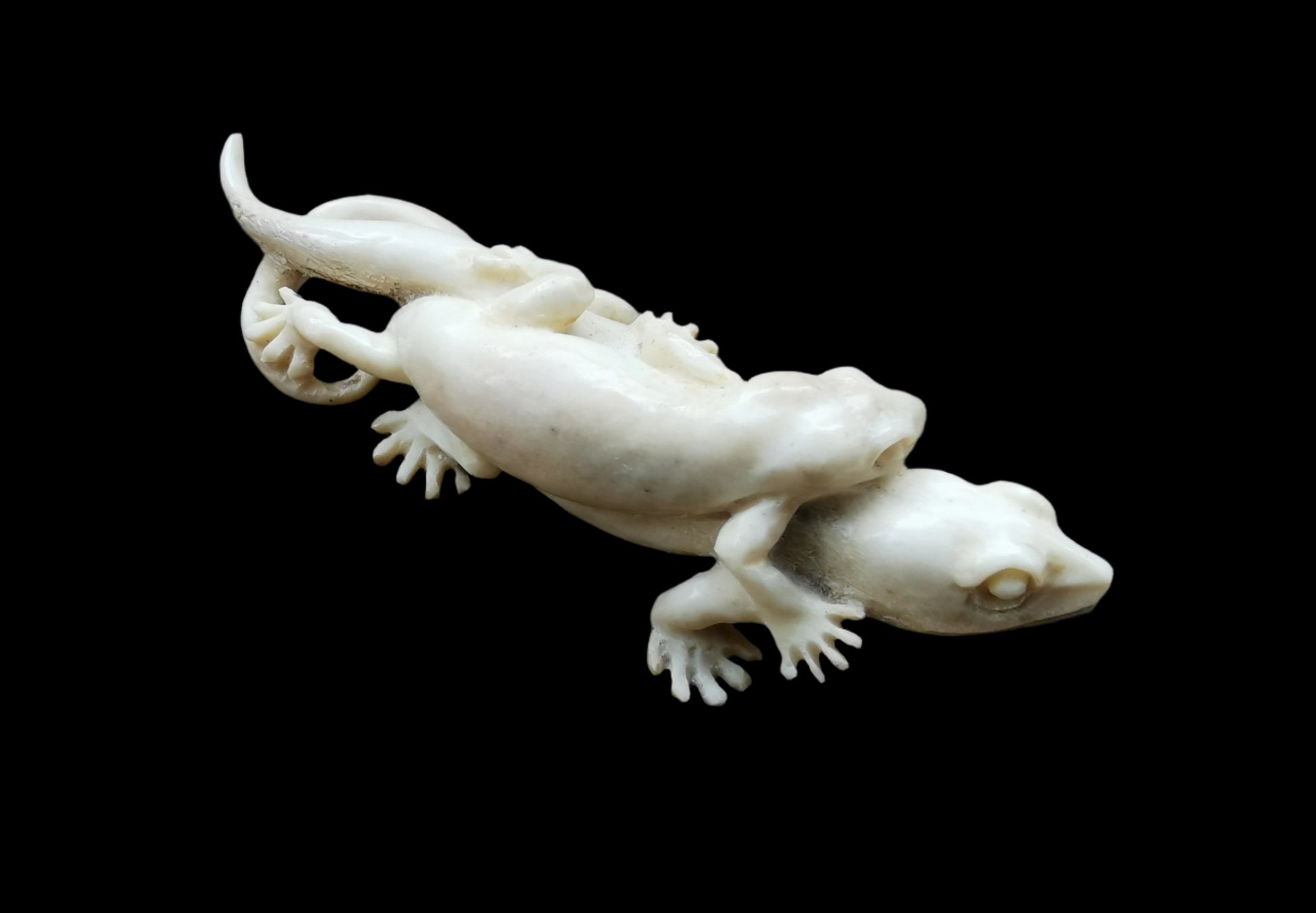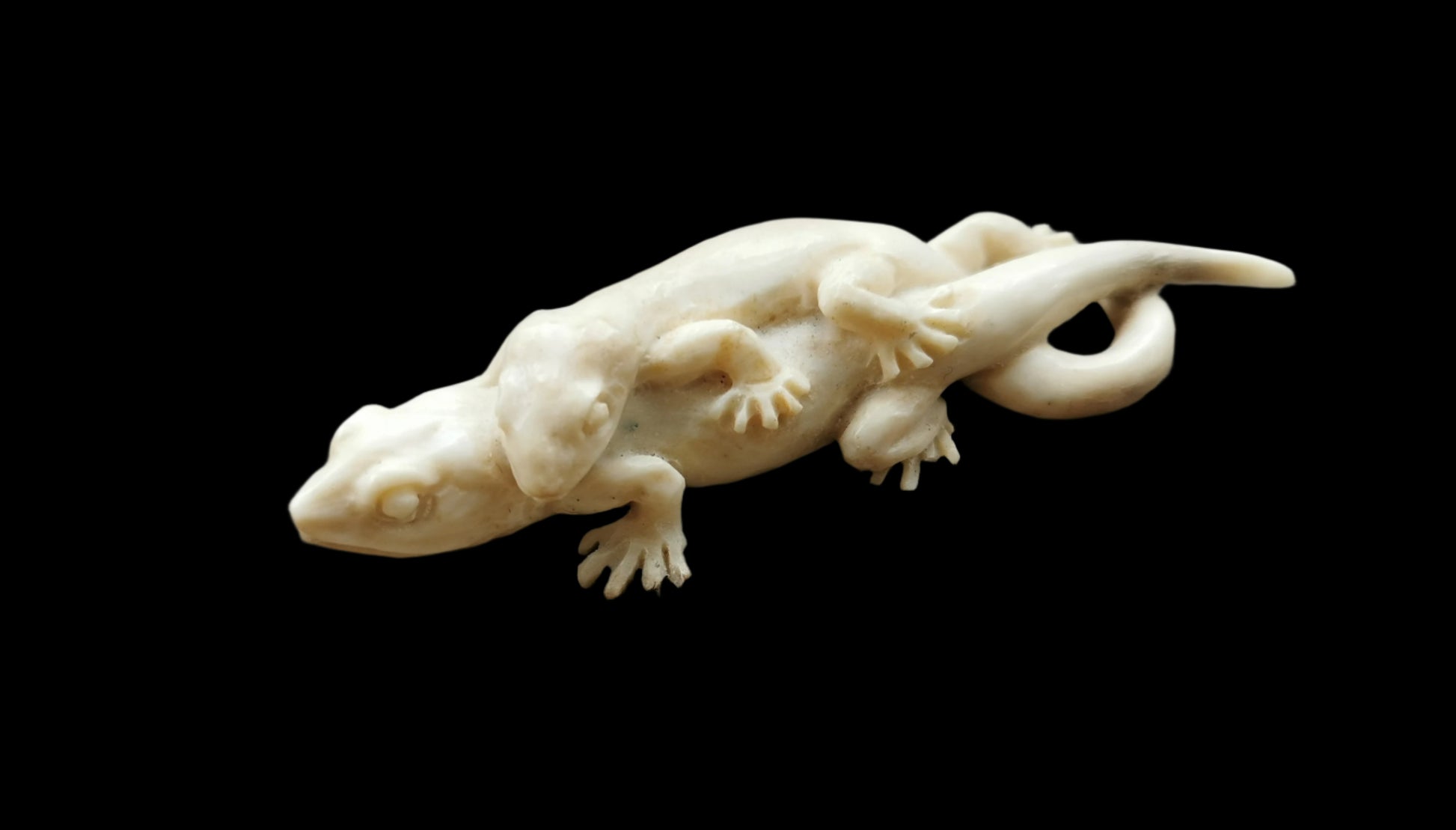Portal Glastonbury
Ref.CR0141
Ref.CR0141
Couldn't load pickup availability
Ref.CR0141 - Ecologically sourced deer horn carved lizard.
The lizard, as a creature with a wide presence across cultures, ecosystems, and mythologies, carries rich and varied symbolic significance. Its unique traits—such as its ability to regenerate its tail, its adaptability to diverse environments, and its association with both earth and sun—imbue it with meanings related to transformation, survival, wisdom, protection, and duality.
Symbolic Significance
The lizard, a small yet remarkable reptile found across diverse ecosystems, carries profound symbolic significance in cultures, mythologies, and spiritual traditions worldwide. Its distinctive traits—such as its ability to regenerate its tail, its adaptability to extreme environments, its alert demeanor, and its connection to both earth and sun—infuse it with meanings of transformation, survival, wisdom, protection, duality, and spiritual insight. The lizard’s presence in folklore, art, and modern symbolism reflects its role as a versatile emblem of resilience, cunning, and connection to the natural and metaphysical worlds.
Transformation and Renewal
One of the lizard’s most striking features is its ability to regrow a severed tail, making it a powerful symbol of regeneration, healing, and renewal. This trait represents the capacity to recover from loss, trauma, or setbacks, embodying personal growth and the cyclical nature of life. In spiritual contexts, the lizard signifies the shedding of old habits or identities, much like it sheds its skin, to embrace new beginnings. This transformative quality resonates with those navigating change, symbolizing resilience and the ability to adapt and thrive despite adversity.
Survival and Adaptability
Lizards thrive in some of the harshest environments, from scorching deserts to dense jungles, symbolizing survival, resourcefulness, and adaptability. Their ability to camouflage, blend into their surroundings, or dart away from danger reflects strategic cunning and quick thinking. In symbolic terms, the lizard embodies the instinct to preserve oneself, whether through cleverness, patience, or timely action. It serves as a reminder of the importance of flexibility and pragmatism in overcoming challenges, making it a totem for navigating unpredictable or hostile circumstances.
Wisdom and Observation
With their keen eyes and alert posture, lizards are often associated with perception, insight, and wisdom. Their watchful nature suggests an attunement to subtle cues in the environment, symbolizing heightened awareness or intuition. In some cultures, lizards are seen as guardians of hidden knowledge, messengers of divine truths, or seers capable of perceiving what others overlook. This makes them symbols of mindfulness, encouraging careful observation and trust in one’s instincts. In spiritual traditions, the lizard may guide individuals toward deeper understanding or clarity in decision-making.
Protection and Spiritual Guardianship
In many cultures, lizards are regarded as protective symbols, believed to ward off negative energies, evil spirits, or misfortune. Their presence in homes or sacred spaces is often interpreted as a sign of spiritual safeguarding or ancestral blessings. For example, in some African and Caribbean traditions, a lizard crossing one’s path or residing in a dwelling is seen as a protective omen, shielding the household from harm. This protective role extends to the lizard’s association with survival, as its ability to evade predators reinforces its image as a guardian of life and security.
Duality and Balance
Lizards embody a natural duality, connected to both the earth (as ground-dwelling creatures) and the sun (as basking reptiles that draw energy from warmth). This balance between terrestrial and celestial elements symbolizes harmony between the material and spiritual realms. The lizard navigates these dualities with ease, representing the integration of opposites—such as instinct and intellect, vulnerability and strength, or grounding and aspiration. In this way, it serves as a symbol of equilibrium, encouraging individuals to find balance in their lives or to embrace the interplay of contrasting forces.
Connection to the Earth and Instinct
As creatures closely tied to the ground, lizards symbolize a deep connection to the earth and its rhythms. Their scurrying movements and sensitivity to environmental changes reflect primal instincts and a grounded, intuitive relationship with the natural world. In many traditions, the lizard is a reminder to stay rooted, trust one’s gut, and remain attuned to the cycles of life. This earthy symbolism also ties the lizard to fertility, growth, and the vitality of the land, particularly in cultures where reptiles are linked to agricultural abundance.
Cultural and Historical Contexts
Native American Traditions: Among various Native American tribes, lizards are symbols of agility, survival, and spiritual insight. They often appear in myths as tricksters or guides, helping humans navigate challenges. In some Southwestern tribes, such as the Hopi, lizards are associated with dream wisdom, believed to carry messages from the spirit world or protect dreamers during visionary journeys. Lizard motifs in pottery and rock art reflect their role as totems of resilience and adaptability in arid environments.
African Folklore: In African cultures, lizards are frequently depicted as cunning figures in oral traditions, such as the trickster lizard in West African tales who outwits larger animals. They are also seen as messengers between the human and divine realms, carrying prayers or warnings. In some regions, a lizard’s appearance is a protective sign, believed to guard against malevolent spirits or bring good fortune.
Aboriginal Australian Culture: In Aboriginal Australian traditions, lizards are significant totemic animals, often linked to specific clans or ancestral beings in the Dreamtime. Species like the goanna (a large monitor lizard) symbolize survival, strength, and connection to the land, embodying cultural laws and responsibilities. Lizard tracks in art and storytelling represent journeys through the landscape, both physical and spiritual.
Ancient Egypt: Lizards were associated with the concept of rebirth, as their basking behavior mirrored the sun’s life-giving energy. They appeared in amulets and art as symbols of renewal, protection, and the cyclical nature of existence, aligning with Egypt’s fascination with resurrection and eternal life.
Mesoamerican Cultures: In Aztec and Mayan traditions, lizards symbolized fertility, agility, and the earth’s vitality. They were often depicted in carvings or codices as sacred creatures linked to agriculture and the cycles of rain and growth. The lizard’s quick movements made it a symbol of divine responsiveness, connecting it to gods of nature and creation.
Hindu and South Asian Traditions: In some Hindu myths, lizards are associated with omens and intuition. Their movements in homes are interpreted as signs of future events, with specific behaviors predicting fortune or caution. In broader South Asian folklore, lizards symbolize humility and adaptability, thriving in modest environments.
European Folklore: In Mediterranean and European traditions, lizards were sometimes linked to healing and protection due to their regenerative abilities. In ancient Greece, symbolized recovery and vitality. However, in some medieval Christian contexts, lizards were viewed with suspicion, mistakenly tied to serpentine imagery and deceit, though this was less common.
Modern Symbolism and Applications
In contemporary contexts, the lizard’s symbolism remains vibrant, adapting to new cultural, ecological, and psychological landscapes:
Pop Culture and Media: Lizards often appear as charismatic, quirky figures in modern media. The Geico gecko, for example, embodies charm, wit, and approachability, leveraging the lizard’s association with cleverness and adaptability. In science fiction and fantasy, lizards or lizard-like creatures (e.g., dinosaurs or dragons) symbolize primal instincts, resilience, or untamed nature, as seen in films like Jurassic Park.
Spirituality and Personal Growth: In New Age and spiritual communities, the lizard is a popular totem or spirit animal, representing transformation, intuition, and adaptability. It encourages individuals to embrace change, trust their instincts, and let go of what no longer serves them, much like the lizard sheds its tail. Meditation practices may use lizard imagery to foster resilience or connect with earthy, grounding energies.
Ecological Symbolism: As key players in ecosystems, lizards symbolize balance and fragility in the natural world. Their sensitivity to environmental changes makes them indicators of ecological health, representing the need for conservation and respect for biodiversity. In this sense, the lizard becomes a symbol of humanity’s responsibility to protect vulnerable systems.
Psychological Metaphors: In psychology, the lizard evokes the “reptilian brain,” the part of the human psyche governing survival instincts and primal responses. Symbolically, it represents the foundational drives that underpin behavior, encouraging awareness of instinctual needs while balancing them with higher reasoning. The lizard also symbolizes the ability to “detach” from emotional burdens, as it detaches its tail to escape danger.
Art and Design: Lizard motifs appear in jewelry, tattoos, and graphic design, often symbolizing agility, transformation, or connection to nature. Their sleek, dynamic forms appeal to those drawn to themes of resilience and adaptability, making them popular in bohemian or nature-inspired aesthetics.
Conclusion
The lizard’s symbolic significance lies in its remarkable ability to embody resilience, wisdom, and balance. Its regenerative powers speak to transformation and renewal, its survival skills highlight adaptability and cunning, and its watchful nature evokes insight and spiritual awareness. Across ancient myths, indigenous traditions, and modern contexts, the lizard serves as a bridge between the earthly and the divine, the instinctual and the enlightened. Whether as a totem of survival in harsh landscapes, a guardian of hidden truths, or a metaphor for navigating change, the lizard remains a timeless symbol of life’s enduring creativity and adaptability.
Size: 66mm/2.6in approx.




